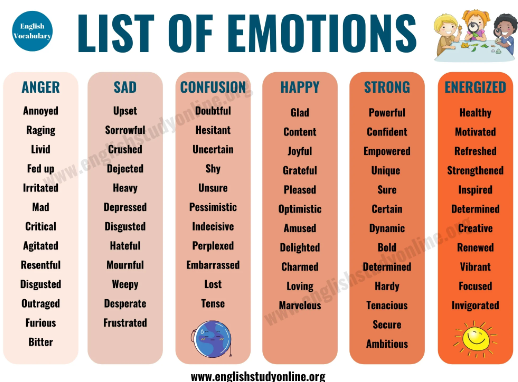Is it really important that we understand our emotions? If it is a happy emotion like excitement, love, or relaxation- no problem. We enjoy upbeat, positive emotions. But what about unhappy emotions such as anger, sadness, or helplessness? They are unpleasant and do we really need to go there? Yes. Yes, we do.
The problem comes about when our behaviors are inconsistent with our emotions. For example, let's say we tell our friend we are happy to have dinner with her and her new boyfriend, but we are actually fearful of her new beau, then our behavior is inconsistent with our emotions. We feel torn. Our initial reaction is fear. But then we start to feel guilt. We feel guilty for not being happy for her. So, we tell her that we would be happy to join them for dinner. When we feel one way but want to do something different; this causes stress and strife in our life. The key, in life (when it comes to emotions), is to express yourself in a way that is consistent with your feelings. When we do so, life is relatively smooth and harmonious. (I say relatively. No one's life is perfect. And I cannot not give you a money-back guarantee that your life will be amazing every day if you do this. And, no, you cannot use this excuse on your boss.)Let's use this example and apply the four steps outlined in the previous article.
Second, determine if they are primary or secondary emotions.
Primary emotions are what you first feel when something happens to you. These emotions just come to you before you have a chance to think. In this example, the emotion is fear.
Secondary emotions are what we feel after we have a chance to think. They are often habitual or learned responses. In this example, guilt is the emotion you feel after you have a chance to think about it.
If the emotion you feel is a primary emotion, why do you think you feel the way you do? Fear is a powerful emotion and is an indicator that something is wrong. In his book, The Gift of Fear by Gavin De Becker, the author met with those involved in traumatic physical attacks. Every single one of the victims stated that they experienced fear before their attacker even approached them but many ignored this early warning sign. Many felt silly for experiencing fear without any logical reason. For example, a young man parked next to a victim at her apartment complex. He saw that she was bringing in several bags of groceries and offered to help her; stating that he lived in the same building. The victim suddenly felt fearful, but then dismissed this feeling as ridiculous. The guy was probably just using this as an excuse to meet girls or to be helpful. She sound found herself the victim of an assault. As mentioned in the book's title, fear is a gift. It is an alert system.
Third, is your emotion at odds with your behavior?
It is much easier to alter our behavior than our emotions. Until you resolve or handle your emotion(s), is there a way you can make your behavior consistent with how you feel? In this example, yes. You are saying one thing but feeling totally different. So, until you decide how you want to approach this situation, is there a way you can change your behavior so it matches your emotions? Yes, you can, This takes some skill and practice. In this case, you may tell your friend you are not available or do not know your availability right at this moment but will get back to her. That will give you a little time to decide how you plan to proceed.
In this step, you need to understand your emotions. Sometimes it may seem obvious, sometimes not as much. You do not need to understand all of the reasons you feel the way you do to come to terms with the emotions. You may or may not ever understand why you are fearful of the new boyfriend. But it means you need to recognize you feel the way you do- not ignore it and shrug it off. Fear is an alert system.
The example above is fairly easy in identifying the emotions- fear and guilt. But what if you aren't sure exactly how you feel? You have a vague idea of what you feel but can't find the exact word for it. There is no definitive single list of all the emotions or words to express how we feel. Some lists include 27 words, others over 50. Enclosed is a list of some emotions to give you ideas. You can look at a list to see what resonates with you. Or, you can use one of my favorite writing tools, the thesaurus. Remember this book you may have used for high school or college English class? You can dust off the old fashioned thesaurus from your school days or now there are also line versions. They are a lot of fun (well, at least I think so). These are great tools to use to help you identify how you feel. Each word has such a different connotation. After all, the word content has a very different meaning than determined. Shy is different than unsure, etc.
I hope the example and tips above help you get a hold of your emotions and the important messages they are sending you. Emotions are not there to make your life harder, but to make it better. Learn to understand and appreciate your emotions rather than let your emotions overpower you.

.gif)
.gif)
.gif)
 .
. 




Comments
Post a Comment